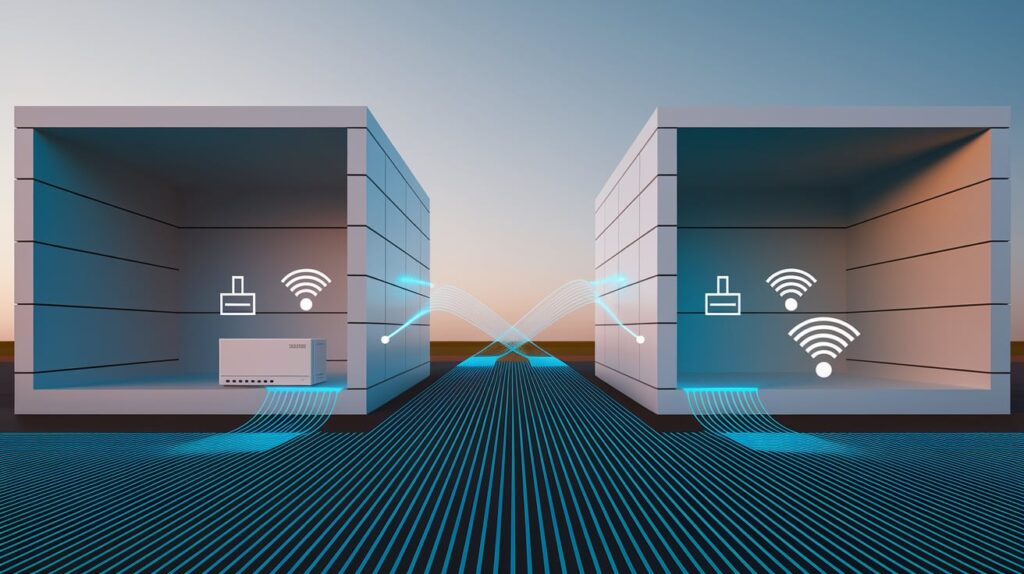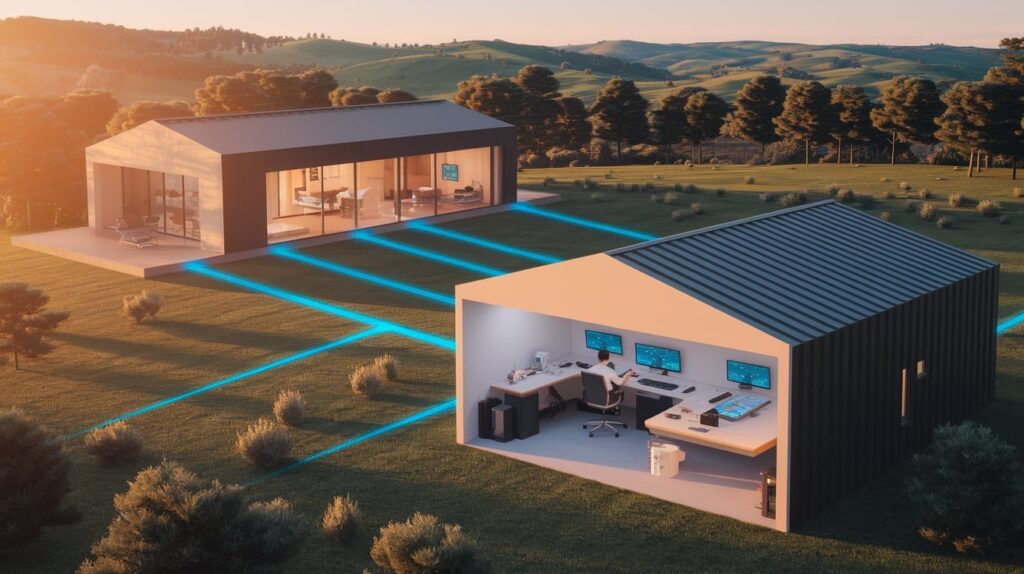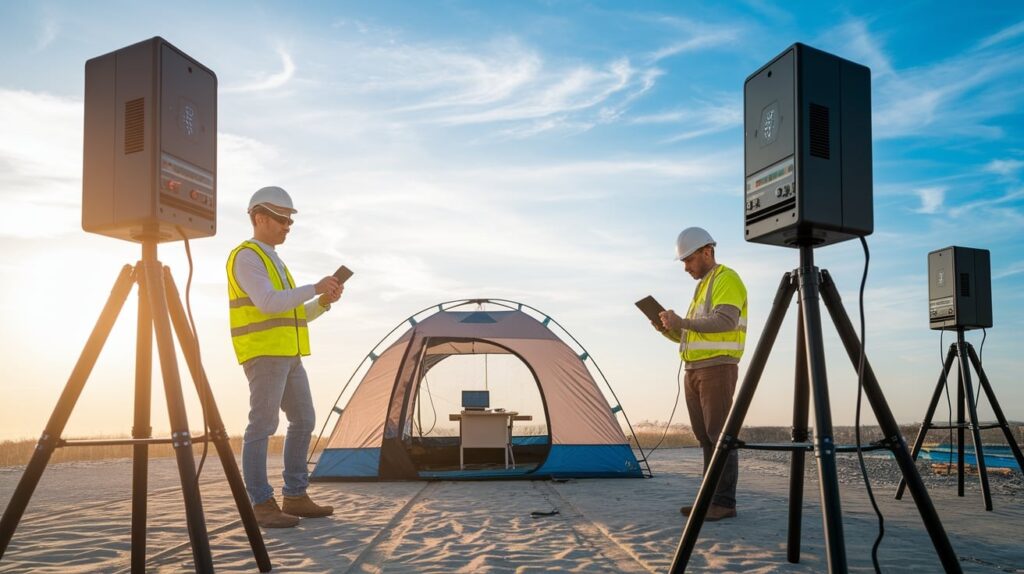Are you looking to connect separate networks without running cables across your property?
Wireless bridges offer a practical solution to this common networking problem.
These useful devices transmit signals between disconnected networks, allowing data to flow freely between buildings or across spaces where physical cables aren’t feasible.
Unlike standard WiFi extenders that simply boost your existing signal, wireless bridges establish a direct connection between two separate networks, maintaining speed and reliability across distance.
In this guide, we’ll examine how these systems work, highlight the top options available this year, and help you select the right one for your specific needs.
Let’s look at what makes wireless bridges an essential networking tool for many homes and businesses.
What Is a Wireless Bridge?

A wireless bridge is a networking device that connects two or more networks without physical cables.
Think of it as building an invisible data highway between separate locations. Unlike other networking tools that simply extend your existing WiFi, a wireless bridge creates a direct link between entirely separate networks.
How does it work?
Connecting Two Networks Wirelessly
Wireless bridges use radio signals to transmit data between two points. Each bridge has a transmitter and receiver that communicate with each other across open space.
The primary bridge connects to your main network and sends signals to a secondary bridge at another location, which then distributes that connection to devices on its local network.
The technology works by converting your wired network data into wireless signals, sending those signals through the air, and then converting them back to wired data at the destination.
This creates a seamless connection between networks that would otherwise remain isolated.
Differences from Repeaters and Extenders
While they might seem similar, wireless bridges serve a different purpose than WiFi repeaters or extenders:
- WiFi Repeaters/Extenders: These devices amplify and rebroadcast your existing WiFi signal to reach farther within the same network. They’re designed to eliminate dead zones in a single network.
- Wireless Bridges: These create a connection between two completely separate networks, allowing them to function as if they were connected by a physical cable. They don’t simply extend range-they link discrete networks together.
Common Use Cases
1. Homes with Detached Garages or Sheds

For homeowners with workspaces or smart devices in detached structures, wireless bridges provide reliable connectivity without digging trenches for cables.
This allows you to extend your home network to outbuildings up to several hundred feet away.
2. Large Properties or Campuses

Organizations with multiple buildings across sprawling grounds use wireless bridges to maintain network continuity throughout their property.
Schools, business complexes, and agricultural operations benefit from this technology when cable installation would be prohibitively expensive.
3. Outdoor Surveillance Systems

Security cameras often need placement in locations far from your main router.
Wireless bridges can connect these remote systems to your primary network, allowing continuous monitoring without complicated wiring solutions.
4. Temporary Remote Setups

Construction sites, outdoor events, or disaster response scenarios often require quick network deployment without permanent infrastructure.
Wireless bridges offer flexible, temporary connectivity that can be established rapidly and moved as needed.
Key Features to Look for in a Wireless Bridge
When selecting a wireless bridge for your networking needs, several critical features will determine how effectively it serves your purpose.
Understanding these key attributes helps you make an informed choice that matches your specific requirements.
1. Speed and Range
What Mbps and GHz Ratings Mean
Mbps (Megabits per second) indicates the maximum data transfer speed of the wireless bridge. Modern bridges typically offer speeds from 300 Mbps to 1,000+ Mbps (1 Gbps).
For context:
- 100-300 Mbps: Sufficient for basic internet browsing and video streaming
- 300-600 Mbps: Good for multiple devices and 4K streaming
- 600+ Mbps: Ideal for bandwidth-intensive applications and many connected devices
GHz (Gigahertz) refers to the frequency band on which the bridge operates:
- 2.4 GHz: Offers better range but slower speeds; can pass through walls more effectively
- 5 GHz: Provides faster speeds but shorter range; more susceptible to physical barriers
Dual-band vs Single-band
Single-band bridges operate on just one frequency (typically 2.4 GHz). They’re generally less expensive but more prone to interference from other devices like microwaves and cordless phones.
Dual-band bridges can switch between 2.4 GHz and 5 GHz frequencies. This versatility allows you to:
- Choose optimal performance based on your environment
- Reduce interference by selecting the less congested band
- Balance range and speed needs to be more effective
2. Security Protocols
Modern wireless bridges should include robust security features to protect your data as it travels between networks:
WPA3 and Earlier Standards
WPA3 (Wi-Fi Protected Access 3) is the latest and most secure protocol, offering improved encryption and protection against brute force attacks.
Earlier standards like WPA2 provide adequate security for most applications but lack some advanced protections of WPA3.
Firewalls and Additional Protections
Quality bridges often include built-in firewalls that monitor and filter network traffic, blocking potential threats before they reach connected devices.
Encryption Methods
Look for bridges that support AES (Advanced Encryption Standard) with at least 128-bit encryption.
This military-grade protection scrambles data during transmission, making it extremely difficult for unauthorized users to intercept.
3. Ease of Setup
Plug-and-play Solutions
Some wireless bridges feature simplified setup processes with:
- Automatic configuration wizards
- Mobile apps for quick installation
- Pre-configured settings that work out of the box
These user-friendly options are ideal for home users or small businesses without dedicated IT staff.
Complex Configurations
Enterprise-grade bridges often require more technical setup but offer:
- Greater customization options
- More precise control over network parameters
- Advanced management features for network professionals
The right choice depends on your technical comfort level and specific networking requirements.
4. Durability and Weatherproofing
Importance of Outdoor Use
For bridges installed outside, environmental protection is crucial:
IP (Ingress Protection) ratings indicate resistance to environmental factors:
- Higher numbers provide better protection (IP65, IP66, IP67)
- The first digit indicates dust protection (5-6)
- The second digit indicates water resistance (5-8)
The operating temperature range should match your local climate conditions. Quality outdoor bridges typically function from -30°C to 60°C (-22°F to 140°F).
UV resistance prevents sun damage to the casing over time, extending the lifespan of outdoor units.
Lightning protection features safeguard against electrical surges during storms.
For indoor-only applications, standard consumer-grade durability may suffice, but for any outdoor installation, robust weatherproofing is essential for long-term reliability.
How to Choose the Best Wireless Bridge for You?
1. Evaluate Your Environment
|
Environmental Factor |
Considerations |
Recommended Features |
|
Urban Setting |
• High signal interference from nearby networks • Buildings and structures blocking the line of sight • Shorter distances are typically needed |
• 5 GHz operation to reduce interference • Higher gain antennas to overcome obstacles • Dual-band capability for frequency flexibility • Advanced QoS features for congested areas |
|
Rural Setting |
• Longer distances to cover • Fewer interference sources • Natural obstacles (trees, hills) • Weather exposure |
• Higher power output for extended range • 2.4 GHz may work better for penetrating foliage • Directional antennas for a focused signal • Superior weatherproofing (IP66+) |
|
Indoor Use |
• Walls and floors create signal barriers • Potential interference from appliances • Less environmental protection is needed |
• Omnidirectional capabilities may be beneficial • Dual-band preferred for flexibility • Aesthetic considerations (size, mounting) • The standard operating temperature range is sufficient |
|
Outdoor Use |
• Direct exposure to elements • Temperature fluctuations • Lightning risks • UV exposure |
• High IP rating (IP65 minimum) • Extended temperature tolerance • Surge protection • UV-resistant housing • Robust mounting options |
2. Speed vs Budget Trade-offs
Selecting the appropriate speed capabilities for your wireless bridge involves balancing your actual needs against cost considerations.
While faster is technically better, it’s not always necessary or cost-effective.
Is Gigabit Speed Necessary?
Before investing in high-speed (and higher-cost) equipment, consider your actual usage requirements:
When standard speeds (300-600 Mbps) are sufficient:
- General internet browsing and email
- Standard HD video streaming (Netflix, YouTube)
- Basic smart home device connectivity
- Small office networks with light file sharing
- Remote monitoring systems
When gigabit speeds become beneficial:
- 4K or 8K video streaming to multiple devices
- Large file transfers between networks
- Backup systems requiring significant bandwidth
- Gaming setups with multiple simultaneous users
- Smart home environments with dozens of connected devices
Cost implications:
- Standard bridges (300-600 Mbps): $50-150
- High-performance bridges (600-900 Mbps): $150-300
- Gigabit+ bridges (1000+ Mbps): $300-1000+
Practical consideration: Your internet service speed often creates a natural ceiling for your needs. If your internet plan provides 200 Mbps, a 1 Gbps bridge won’t make your internet faster, though it might still benefit internal network transfers.
3. Compatibility with Existing Devices
Ensuring your wireless bridge works seamlessly with your current networking equipment is essential for avoiding frustrating compatibility issues and additional expenses.
Routers
Key compatibility factors:
- Networking standards (802.11a/b/g/n/ac/ax)
- Management interfaces (does your router support the bridge’s configuration requirements?)
- IP addressing schemes (static vs. dynamic requirements)
- VLAN support is needed for network segmentation
- QoS (Quality of Service) compatibility for traffic prioritization
Integration tips:
- Check if your router manufacturer offers specific bridge recommendations
- Consider bridges from the same manufacturer as your router for optimal compatibility
- Look for bridges with flexible configuration options that can adapt to your router’s capabilities
Antennas
If your system uses external antennas:
- Match connector types (N-type, RP-SMA, SMA)
- Check polarization compatibility
- Verify frequency band matching
- Ensure gain ratings are appropriate for your distance needs
Security Systems
For connecting surveillance or access control systems:
- Verify bandwidth requirements for video streams
- Check latency tolerance for real-time applications
- Ensure the bridge supports any specific protocols used by your security systems
- Confirm compatibility with VPN requirements if using secure remote access
- Check PoE (Power over Ethernet) compatibility if your security devices use this feature
Network addressing considerations:
- Some security systems require specific IP addressing schemes
- Certain devices may need static IP assignments
- DHCP relay functionality might be necessary depending on your setup
By carefully evaluating these compatibility factors before purchase, you can avoid the frustration and expense of acquiring equipment that won’t integrate properly with your existing network infrastructure.
Conclusion
Wireless bridges provide a practical way to connect networks across spaces where cables aren’t feasible. As we’ve seen, the right choice hinges on understanding your specific needs.
Consider your environment carefully, urban settings need different solutions than rural ones.
Be realistic about speed requirements, too; paying for gigabit capability makes sense only if you’ll use that bandwidth.
And don’t overlook compatibility with your existing network gear to avoid headaches later.
From budget-friendly options like the TP-Link CPE210 to premium solutions such as the Cisco Aironet series, today’s market offers choices for every situation and budget.
The best wireless bridge isn’t necessarily the most expensive one, it’s the one that addresses your specific connectivity challenges efficiently.
With the right wireless bridge in place, you’ll enjoy seamless connectivity across your entire property or campus without extensive cabling.
Frequently Asked Questions
How far will a Wi-Fi bridge work?
Wi-Fi bridges typically work from 100 feet up to 15 kilometers, depending on model, antenna strength, and clear line-of-sight conditions.
What is the difference between a Wi-Fi bridge and a mesh?
Bridges connect separate networks across distances. Mesh creates one unified network with multiple access points, providing seamless coverage throughout a space.
Is WAP better than mesh WiFi?
Neither is universally better. WAPs work well for specific coverage spots, while mesh excels at providing seamless roaming and complete home coverage.








